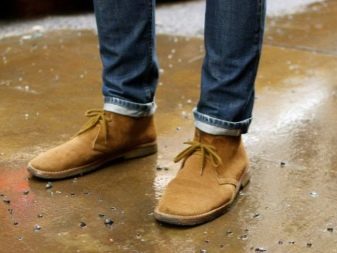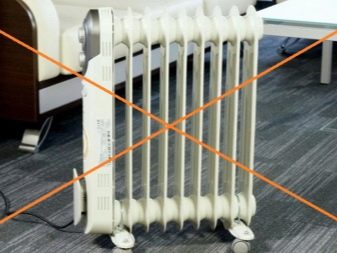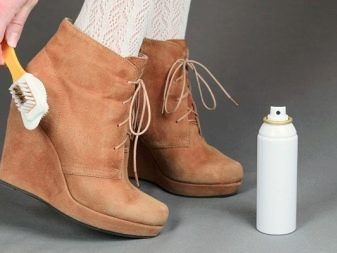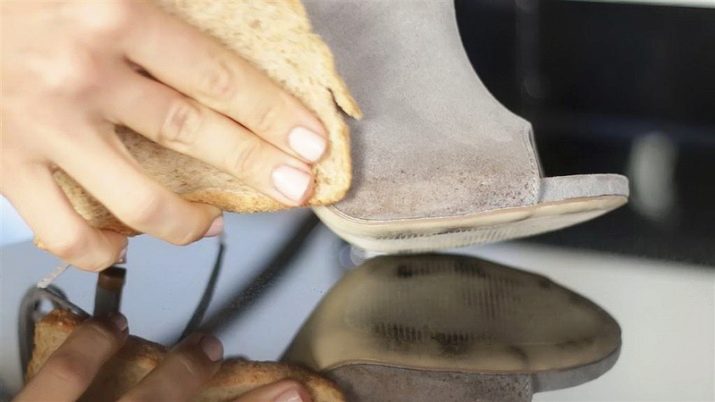Proper shoe care, regardless of the season, is a must-have event that will ensure its proper appearance and long service life. This is especially true for suede shoes, since it requires a special approach to operation and maintenance, therefore, before purchasing such a model, it is important to have an idea of the methods and means intended for servicing suede products.

How to clean suede?
The popularity of such shoes among both men and women is due to the peculiarity of the material to transform the appearance of the shoe, adding an image of elegance, while increasing the level of comfort during operation due to the softness and suppleness of the material.
However, seasonality and climatic features sometimes make adjustments to a person’s life, which as a result forces the owner of a suede shoe to walk in it through puddles and mud or snowdrifts where direct contact of suede with various chemical reagents is a necessary measure. In addition, there are cases when, due to certain circumstances or due to negligence, shoes get dirty with various greasy or coloring compounds. The same water is left on the suede salt streaks, which spoil the look of the shoe and the quality of the material.


Taking into account all the above points and buying shoes from suede, you need to have a clear idea of what tools and auxiliary items are recommended to be used for cleaning and caring for them at home.
First of all, it is necessary to dry wet shoes, boots or sneakers: for this, the shoes should be blotted out with a dry, lint-free rag, and put several crumpled newspaper folds inside to fill the entire space as much as possible, regardless of whether artificial or natural suede was used to make shoes.
If the shoes are made in light shades, to fill them you must use white paper without the presence of a printing press. To speed up the drying process of the material, the paper inside can be changed every half hour, but provided that it has become wet.


To clean the material it should not be rubbed - this applies to the removal of traces and dirty spots after rain, as this will lead to the fact that the dirt only penetrates deeper into the material between the villi.
Dry suede should be dried at room temperature, it should not be placed near heating appliances, since there is a great risk that the shoes will lose their shape.
When the dirt has completely dried on the base, it can be removed with a brush. Such a useful accessory is usually sold in shoe stores along with products and professional care products; You can also buy it in a regular hardware store or in supermarkets in specialized departments where funds for shoes are offered.
Such an accessory is usually made three-way, on each side there is a different pile; as a rule, this is the rubber side, the side with soft bristles and the area with metal teeth. Polyurethane fibers will help lift the suede, after it is wet and sticky, the second side is used to remove wipes and greasy marks on dry shoes, the latter gives the product and the fibers the correct location and helps to clean off more stubborn dirt.


In the absence of such an item in everyday life, it is best to make a substitute at home: for this, you can use an old toothbrush, a rag made from rough materials or an ordinary brush for clothes.
It is necessary to work with a brush strictly in one direction, and places such as the joints between suede and sole, where it is not possible to remove dirt with a brush, can be treated with an ordinary cotton swab. The brush can cope with the main surface layer of existing contaminants, remove dust, and also remove traces of salt; but in order to get rid of deeper and older spots on shoes, especially white or beige, you will need additional funds designed for suede and much more effort.

How can I clean?
The next step, which relates to the removal of dirt and other contaminants from suede, is a water-repellent treatment, which is performed by specialized means. It is most correct to carry it out immediately after acquiring a new pair of shoes, spraying the material with an aerosol so that it becomes well moistened from the composition. Then it is necessary that the suede is completely nourished and dried at ordinary temperature. As a rule, such a treatment can protect the shoes from getting wet for a certain period of time, after which the procedure will need to be repeated. Today you can find on sale a huge number of various products that are recommended for use with suede and nubuck. A feature of the product is a composition containing almond oil. This substance provides gentle care and performs protective functions.


Cleaning suede shoes involves not only water-repellent impregnation and brushing, but also refreshing care so that the shoes always have an attractive appearance. For these purposes, there are special aerosols, creams or liquid formulations that have a color similar to a diverse palette of suede.
To remove serious contaminants from shoes, even with the regular use of products that repel water and maintain color brightness, you will need certain funds that can be additionally purchased or made independently at home.

Special compounds
Today, you can easily buy specialized products to combat dirt and serious stains on suede shoes. Among the most popular brands are Saphir, Kiwi or Salton. All products of professional cleaners can be classified as follows.



A series of protective creams for velor and suede
Such compositions after application to the material form a reliable protective layer. Usually applying the cream with a sponge or brush only on clean and completely dry shoes. Among the sought-after brands, Duke Velours Nubuck can be distinguished.


Sprays for processing suede shoes
Such compositions can remove stains and traces of shoes from salt and road chemicals, in addition, the compositions restore the material, provide water-repellent qualities and can easily cope with other types of pollution. The brands that are in demand include Davidik spray or Silver Premium 3 in 1 spray.


Shoe polish
The product qualitatively soaks the pile of material, cleans dirt and traces of salt; use such formulations is strictly according to the instructions. The products of the Salton brand are very popular.


Coloring agents
Allow to give the material its original color and paint over traces of contaminants that cannot be removed.
In addition, to help care for suede shoes, you can buy sponges and all kinds of erasers, which are recommended to be used daily after wearing boots, shoes or sneakers. The essence of removing stains and stains is the dry cleaning method, when the area on the material that has defects with dirt is rubbed with an eraser or sponge until the stubborn substance is completely removed into the pile.


Specialized formulations can also be selected based on the type of contaminants present on the material. There is a universal product, as well as compositions for combating greasy marks, salt stains or to restore the color that shoes have lost in the process of frequent contact with chemicals. Information on the purpose of a particular composition is indicated by the manufacturer in the instructions and on the spray can, package or tube with a shoe.
The multi-cleaner is Saphir Detacheur Hiver-Winter or Tarrago Leather Care. Kiwi belongs to the class of cleansing foam, Crep Protect is recommended to restore the attractiveness of the material.




Folk remedies
In order to get rid of various traces and spots on suede, compositions that can be prepared independently at home are considered quite effective. However, there are some recommendations and features of a particular tool, as well as a number of preparatory measures for shoes and material.

You should know that you can remove dust, grease or other substances with folk remedies if the shoes are dry and stuffed with paper or newspapers.
Starch, tooth powder, powder, salt, sand, crushed chalk
In each house, there is guaranteed to be one of the above substances. Such bulk products will help remove grease stains from the material. The most tangible results can be achieved when working with fresh contaminants. To do this, it is necessary to slightly heat the sand or powder, treat it with a dirty area of the material and leave it in this state for several hours. After that, the remains of the granular substance can simply be brushed off or brushed off.


Eraser or bread crumb
Sometimes in the fight against dirt, a good gum will be a good gum. Instead, you can take a simple bread crumb of a suitable color, and use a bread crust instead of a brush.
The above funds relate to the options for dry removal of various contaminants from suede. Next, we will consider ways to use folk remedies, which involve wet cleaning of dirty material.

Soap composition
In cases where powders and other bulk products did not bring the expected effect, you can prepare a soap composition from ordinary or laundry soap, or shampoo, whipping it until a foam forms. However, in this version it is important that the products used do not contain dyes or bleaches and chlorine, so as not to spoil the color and texture of suede. For persistent exposure to a soapy solution, you can drip a few drops of ammonia.
Work with the composition as follows: on a clean sponge, you need to collect foam and rub the composition into the material in a circular motion, you should avoid abundant water on the shoes. After processing, the sponge must be rinsed in order to remove the remnants of the foam composition from the material.

Vinegar and ammonia
This option copes with dirt and traces of salt. To prepare it, you need to dilute ammonia and vinegar in a small amount of water in a ratio of 4: 1. Moisten any rags or a cotton swab with a tool and treat the necessary area of shoes. Then remove the product with water. After the final drying, a brush should be walked along the suede pile to raise the adhering hairs.

Steam
Many housewives at home get rid of dirt on their shoes by holding it over steam, however, this method has its drawbacks, since water can contain a variety of impurities that, after drying, will stain the material. Therefore, using this option, you should be sure of the quality of the water used so as not to harm the shoes.

Milk and soda
This method is recommended for the care and cleaning of light suede products. To prepare the composition, you need to dissolve baking soda in the amount of one teaspoon in 100-150 ml of milk and add a few drops of ammonia there. They clean the shoes with a sponge, wetting the edges as part of it and slightly rubbing the place with pollution. Then, with a damp sponge moistened with water, you need to remove the rest of the composition from suede.

Alcohol and water
Such a tool can be used for suede of any color. To make a cleanser you need to mix the ingredients in equal parts, apply them to the problem area, then rinse with plain water.

Coffee grounds
This product should only be used on dark suede shoes. It is applied to the surface of the product and rubbed with light pressure. After the gruel has dried, it must be removed from the shoe with a napkin, sponge or cloth. To remove the thick, you can additionally use an eraser.

Gasoline and Talc
The cleaning process with a similar tool involves treating the contaminated suede with gasoline, after which the area must be sprinkled with a large layer of talc and leave the shoes in this state for 2-3 hours, and then clean the material with a hard brush.

Pollution prevention
Careful attitude to shoes, as well as observance of storage rules, can not always protect against the appearance of pollution, but regular preventive measures will greatly facilitate the removal of pollution. A huge role is played by the use of water-repellent compounds that protect the material not only from moisture, but also from dirt and various impurities that it contains on the street, because the product creates a certain barrier that prevents the deep penetration of dust and dirt inside.

In addition, it is important to avoid contact of suede with sunlight during storage. A good prevention of dust accumulation on the pile will be regular “combing” of suede, which will allow you to remove deep accumulations of dirt, raising the villi, which increases the appearance of shoes. It is best to keep suede shoes by wrapping a pair of paper.

It’s best to have different care brushes for multi-colored shoes, and regular care is needed for a light-colored shoe so as not to stain the shoes with old dust from it again.
Cleaning should be carried out in only one direction, and before each exit to the street, especially in the off-season and in winter, suede shoes are best treated with special compounds and impregnations.

See how to clean suede shoes at home in the next video.










